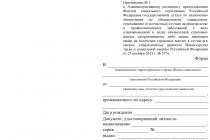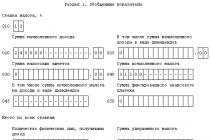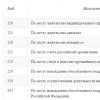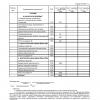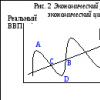Illustration: Clerk
We won’t teach you how to become a financial director in one article, but we tried to include the main thing for the seed.
Financial analysis - the study of the main indicators, coefficients that give an objective assessment of the current financial condition organizations for the purpose of making managerial decisions.
Calculating financial indicators, you can learn about current position affairs at the enterprise, problems and evaluate its opportunities and prospects in the future.
Competent analysis allows you to correctly build a development strategy, improve the mechanism for managing assets and attracted funds of the company.
Who needs financial analysis
Results Users financial analysis all participants in financial and economic activities speak:The following users are interested in such information:
- managers and leaders of the enterprise;
- employees of the enterprise;
- shareholders and business owners;
- buyers and customers;
- suppliers and contractors;
- investors;
- arbitration managers;
- tax authorities.
Source of information for financial analysis
The main source of information for financial analysis is the financial statements of the organization.Basic forms financial statements— Balance sheet and Statement of financial results. These forms make it possible to calculate all the main financial indicators and ratios.For more deep analysis you can use traffic reports Money and a statement of changes in the capital of the organization, which are compiled at the end of the year.
The procedure for calculating financial ratios and analysis of the results
Consider the main groups of indicators financial activities organizations, calculation procedure financial ratios and give recommendations on how to properly analyze the results.Groups of financial analysis indicators
More than 200 ratios are used in financial analysis.All these coefficients characterize four main aspects - indicators of the financial performance of any organization, namely:
- liquidity;
- profitability;
- asset turnover;
- market price.
The coefficients are calculated depending on the task of financial analysis and the range of users for whom the information of the company's financial activities is intended.
Financial ratios and financial performance indicators
Here are the main financial ratios for each group of performance indicators:The group of liquidity indicators includes coefficients:
- absolute liquidity;
- current liquidity;
- quick liquidity.
- profitability working capital;
- profitability of sales;
- return on assets;
- return on net assets;
- profitability equity.
- asset turnover;
- turnover current assets;
- turnover of inventories;
- turnover of receivables (accounts payable).
- earnings per share;
- dividend income;
- share price growth;
- payments;
- market (real value) of the enterprise;
- price/earnings per share.
Key financial ratios
Let us consider in more detail the coefficients of each of the groups of indicators of the company's financial performance.Liquidity indicators
The company's ability to repay its obligations through the sale of current assets is one of the conditions for its financial stability.To assess the stability of the organization allow liquidity ratios.
Liquidity is the ability of assets to be quickly sold at a price close to the market.The easier and faster you can get the full value of an asset, the more liquid it is.
The rate of sale of assets can be:
- High - in relation to property that does not need to be sold (cash), and the property that will be sold quickly enough ( cash equivalents, such as highly liquid debt securities);
- Fast - for property that requires some time for sale, but not very much (short-term debt of debtors);
- Medium - for property that will not be sold very quickly and may lose part of its value during the sale (stocks, of which work in progress may be difficult to sell).
In the Russian balance sheet the company's assets are arranged in descending order of liquidity.
They can be divided into the following groups:
- Highly liquid assets (cash and short-term financial investments);
- Marketable assets (short-term receivables, i.e. debt, payments on which are expected within 12 months after the reporting date);
- Slowly realizable assets (other, not mentioned above, current assets);
- Hard-to-sell assets (all non-current assets);
- Absolute - for property with a high rate of sale;
- Fast, which can also be called urgent, strict, intermediate, critical, or be called the intermediate coverage ratio, for property that has a high and fast speed of sale;
- Current - for property, the rate of sale of which corresponds to the sum of all 3 listed rates.
The higher the liquidity ratios, the higher the solvency of the company.
Note that each of the liquidity ratios reveals information of a different nature.So the current liquidity ratio is of interest primarily to investors, the absolute liquidity ratio is useful for suppliers of goods (works, services), and the quick liquidity ratio is necessary for creditors.
Current liquidity
The current liquidity ratio is one of the main calculated characteristics that assess the company's solvency.This is the most common and commonly used measure of liquidity.
The current liquidity ratio reflects the company's ability to repay current (short-term) liabilities at the expense of current assets only.
Thus, the current liquidity ratio shows in what part of the current assets available to the company when they are sold at market price will cover Short-term liabilities enterprises.The current (total) liquidity ratio is a financial ratio equal to the ratio of current (current) assets to short-term liabilities (current liabilities).
They take data to determine the current liquidity ratio from the balance sheet of the enterprise, compiled on any of the reporting dates.
This is usually the annual balance sheet, but interim reporting may also be used.
To see the nature of the change in this indicator over a number of periods, make several definitions of it for different reporting dates.
Current liquidity ratio formula:
Current Liquidity = Current Assets / Current Liabilities
Since the data for calculating the indicator in question is taken from the balance sheet, the current liquidity formula for the lines of the current form of this report will look like in the following way:
Of the entire amount of section V (i.e., of the total amount of short-term liabilities):A coefficient value of at least 1 is considered normal.Current liquidity = line 1200 / line 1500
The higher the indicator, the better the solvency of the enterprise.
- Page 1200 - line number of the total of section II "Current assets" of the balance sheet;
- Page 1500 - line number of the total of section V "Current liabilities" of the balance sheet.
That is, it is necessary that the total value of current assets be greater than the sum of short-term liabilities.
A value below 1 indicates high financial risk associated with the fact that the company is not able to consistently pay current bills.
A value greater than 3 may indicate an irrational capital structure.
Quick liquidity
The quick liquidity ratio is a financial ratio equal to the ratio of highly liquid current assets to short-term liabilities (current liabilities).The quick liquidity ratio depends on the rate of sale of highly and quickly liquid assets, which include:
- Short-term debt of debtors (sold quickly);
- Short-term financial investments (highly liquid);
- Cash (does not require sale).
The source of data is the company's balance sheet, more often the annual balance sheet, but interim reporting is also possible.
Quick liquidity ratio formula:
Quick liquidity = (Short-term receivables Short-term financial investments Cash) / Current liabilities
Based on the line numbers of the balance sheet, the formula for the quick liquidity ratio on the balance sheet can be displayed as follows:
Quick liquidity = (line 1230 line 1240 line 1250) / (line 1510 line 1520 line 1550)
- Page 1230 - short-term debt of debtors;
- Page 1240 - short-term financial investments;
- Page 1250 - cash balance;
- Page 1510 - the balance of short-term borrowed funds;
- Page 1520 - short-term debt to creditors;
- Page 1550 - other short-term liabilities.
If the quick liquidity ratio is equal to or greater than 1, then the company is able to ensure the rapid full repayment of its current debt at its own expense. Moreover, part of these funds (if the coefficient is greater than 1) will still remain with the organization.
When the quick liquidity ratio is less than 1, the company will not be able to quickly repay all of its current debt own funds.
At the same time, the quick liquidity ratio, which is in the range of 0.7-1, is considered acceptable, since it is common practice to do business with debts.
A quick liquidity ratio less than 0.7 indicates an unfavorable situation, especially if the numerator contains the bulk of the amount accounted for by accounts receivable, among which it may be doubtful.
Absolute liquidity
The absolute liquidity ratio shows what proportion of existing short-term debts can be repaid at the expense of the enterprise in the shortest possible time, using the most easily sold property for this.They determine the initial data for calculating the absolute liquidity ratio for the balance sheet drawn up on a specific reporting date, or for reporting for a number of dates, if you want to trace the dynamics of this indicator.
The absolute liquidity ratio is a financial ratio equal to the ratio of cash and short-term financial investments to short-term liabilities (current liabilities).
Absolute liquidity ratio formula:
Absolute liquidity = (Cash short-term financial investments) / Current liabilities
Based on the line numbers of the balance sheet, the formula for the absolute liquidity ratio for the balance sheet can be displayed as follows:
Absolute liquidity = (line 1250 line 1240) / (line 1510 line 1520 line 1550)
- Page 1250 - line number of the balance sheet for cash;
- Page 1240 - line number of the balance sheet for financial investments;
- Page 1510 - line number of the balance sheet for short-term borrowings;
- Page 1520 - line number of the balance sheet for short-term debt to creditors;
- Page 1550 is the line number of the balance sheet for other short-term liabilities.
This means that the company is able to repay from 0.2 to 0.5 short-term debts as soon as possible at the first request of creditors.
Accordingly, a higher value of the indicator indicates a higher solvency.
Exceeding the value of 0.5 indicates unjustified delays in the use of highly liquid assets.
Profitability indicators
Profitability ratios of an enterprise reflect the degree of profitability by various types assets and efficiency of use of material, labor and monetary and other resources.They are calculated as the ratio net profit to the amount of assets or flows from which it was received.
For this, accounting data are used (Form No. 1 and No. 2).
The higher the values, the more efficiently the analyzed resources of the enterprise are used.
Owners and shareholders are interested in profitability indicators.
Profitability ratios play important role in the development of investment, personnel, and marketing strategies of the company.
Return on working capital
The profitability of working capital reflects the effectiveness of their use in the manufacturing process.The profitability of working capital will be the greater, the less resources the company spends to increase profits.
Working capital profitability formula:
Return on working capital \u003d Net profit / working capital
If you use accounting lines, then:The higher the indicator obtained, the more efficiently the own working capital is used.Return on working capital = p. 2400/p. 1200
Page 2400 - line of the report on financial results (net profit of the company);
Page 1200 - line of the balance sheet (value of working capital).
The normative value of the profitability of working capital is more than 1.
The profitability ratio of working capital with a total of more than one means effective use working capital and testifies to the receipt of profit by the enterprise.
A negative result demonstrates the wrong organization of production.
Profitability of sales
Profitability of sales shows, profitable or unprofitable activity of the enterprise.Profitability ratio, sales determines the share of profit in each earned ruble and is calculated as the ratio of net profit (profit after tax) for certain period to cash-denominated sales for the same period.
The formula for the profitability ratio of sales:
Return on sales \u003d Net profit / Revenue x 100%
To calculate the profitability of sales, information from the income statement (form No. 2) is used:There are no special standards for the profitability of sales.Gross profit margin = line 2100 / line 2110 × 100
Return on sales by operating profit = (line 2300 line 2330) / line 2110 × 100
Return on sales based on net profit = line 2400 / line 2110 × 100
The average statistical values of profitability by industry are calculated.
For each type of activity, its own coefficient is considered normal.
In general, a coefficient ranging from 1 to 5% indicates that the enterprise is low-profitable, from 5 to 20% - medium-profitable, from 20 to 30% - highly profitable.
A coefficient over 30% indicates super-profitability.
Return on assets
Return on assets shows the ability of the company's assets to generate profit and is an indicator of the efficiency and profitability of the company.The return on assets ratio is calculated as the ratio of profit to average cost assets of the enterprise and reflects the amount of net profit from each ruble invested in the assets of the organization.
To do this, the indicator from form No. 2 "Report on financial results" is divided by the average value of the indicator from form No. 1 "Balance sheet".
Return on assets, as well as return on equity, can be considered as one of the indicators of return on investment.
Return on assets formula:The denominator of the formula should be the average value of the value of current assets.Return on assets = profit for the period / average value of assets for the period x 100%
Profit indicators for the numerator of the return on assets formula should be taken from the income statement:
sales profit - from line 2200;
net profit - from line 2400.
If the profitability of all assets is considered, then the balance sheet is taken (line 1600).
If the profitability of current assets is considered, then the result of section II of the asset balance is taken (line 1200).
If they are interested in a separate type - information from the corresponding line of the second section.
When calculating profitability non-current assets the denominator should reflect the total for section I - line 1100. Then we get the profitability of all available non-current assets.
If necessary, you can analyze the profitability of assets separate species, for example, fixed assets or a group of non-current assets (tangible, intangible, financial).
In this case, the formula is substituted with data on the lines that reflect the relevant property.
The higher the indicator, the more effective the entire management process is, since the indicator of return on assets is formed under the influence of all the company's activities.
For financial organization 10% or more is considered normal, for a manufacturing company - 15-20%, for a trading company - 15-40%.
Return on equity
The return on equity shows how effectively the investments of the business owner, investor in this enterprise were used.In other words, how many kopecks of income each ruble of its own capital brings to the enterprise.The return on equity is calculated as the quotient of dividing the net profit received for the period by the equity of the organization.
Equity return on equity formula:
Return on equity = Net profit / Equity x 100%
The net profit of the organization is taken according to the "Report on financial results", equity - according to the liabilities of the balance sheet.
Return on equity on the balance sheet:
Return on equity = line 2400 / line 1300 × 100.
The current liquidity ratio is a key indicator that characterizes the liquidity of an enterprise. It is widely used by banks and other financial institutions when providing loans to businesses. Therefore, the question of how to improve the current liquidity ratio worries entrepreneurs and financial directors.
The CFO needs to “know the enemy by sight” well and correlate the strategies implemented by top management with their impact on liquidity indicators. To do this, you need to focus on current liabilities and assets, as well as to monitor the value of the liquidity ratio and the variables that determine it regularly throughout the year.
What is the current ratio
The current liquidity ratio is an indicator obtained by dividing the value of current assets by the value of the company's current liabilities, for the calculation we use the average for reporting period meaning.
Current ratio formula
Current liquidity ratio = Value of current assets / Value of current liabilities
The resulting figure is important because it reflects the firm's liquidity. It is generally assumed that the higher the ratio, the higher liquidity and vice versa. However, it is rash to draw such conclusions only on the basis of this ratio without a detailed study. To illustrate, the following situations can be given:
- In the event of a drop in sales, the level of stocks will increase, which increases the value of the current liquidity ratio, but at the same time affects real liquidity rather negatively, you cannot pay creditors with goods in warehouses if necessary.
- Delay payment by customers will increase the size accounts receivable, which, in turn, will increase the size of current assets, but again, this will not improve, other things being equal, the real liquidity of the company, since the probability of returning 100% of clients' debts at the right time is unlikely.
Download helpful documents:
Calculation of the current liquidity ratio on the balance sheet
The basis for calculating the coefficient is the balance sheet of the organization, in particular:
- line 1200, which contains information about all current assets of the company: stocks, receivables, cash in accounts and others;
- line 1510 - credit balance account 66, reflecting information on the balances of the organization's debt on short-term bank loans and loans;
- line 1520 - containing summary information (credit balance) on accounts 60.62, 68.69,70,72,73,75,76, which in turn form a short-term accounts payable ;
- line 1550 - other short-term liabilities that are not included in the above sections (account balance 86);
- line 1170 - " Financial investments” if these investments can be quickly realized or returned.
The liquidity ratio is calculated at the time of reporting.
Balance sheet current ratio formula
Cl \u003d (Line 1200 + Line 1170) / (Sum of lines 1510,1520 and 1550)
It should be noted that short-term liabilities in this case should not include the value of lines 1530 “Deferred income” and 1540 “Reserves upcoming expenses» ( estimated liabilities), which in their essence are not real obligations, but reserves created by the organization for its own purposes.
Target range of current ratio values
The probability of realizing all assets at once at 100% of the cost is very small, for this reason the ratio of current assets and current liabilities as 1:1 is not optimal.
However, in financial world there are tools through which you can quickly attract financing for existing assets, incl. under accounts receivable ( factoring), also many assets can be quickly and successfully sold by providing a discount to the market price. Hence, there is a need to cover current liabilities with assets, taking into account their value in case of a quick sale or discount for the purpose of attracting financing, on average, the depreciation of assets is from 50%, therefore, a favorable ratio of current assets and liabilities will be 1.5-2.5: 1. The excess of the value of assets over liabilities performs the function of a "margin of safety" for the company and is called the "margin of safety" in Western sources.
An example of calculating the current ratio
Let's assume the following dynamics of balance indicators (table 1).
Table 1. Balance (fragment)
|
Line code |
||||
|
Section I. Non-current assets |
||||
|
Intangible assets |
||||
|
fixed assets |
||||
|
Profitable investments in material values |
||||
|
Financial investments |
||||
|
Other noncurrent assets |
||||
|
Total for Section I |
||||
|
Section II. current assets |
||||
|
VAT on purchased assets |
||||
|
Accounts receivable |
||||
|
Cash and cash equivalents |
||||
|
Other current assets |
||||
|
Total for Section II |
||||
|
Assets Total |
||||
|
Section III. Capital and reserves |
||||
|
Authorized capital |
||||
|
Undestributed profits |
||||
|
Total for Section III |
||||
|
Section IV. Long-term liabilities |
||||
|
Long-term loans |
||||
|
Total for Section IV |
||||
|
Section V. Short-term liabilities |
||||
|
Short-term credits and loans |
||||
|
Accounts payable |
||||
|
Other current liabilities |
||||
|
Section V total |
||||
|
Total Liabilities |
Then the current liquidity ratio will have the following form (table 2).
table 2. Calculation of the current liquidity ratio
|
Current assets ratio |
As we can see from the table, in 2015 and 2017 the liquidity indicator falls within the acceptable range of liquidity, in 2016 liquidity decreased, but apparently the management drew the appropriate conclusions and took preventive measures, so that next year the situation has reached the target range.
How to increase the liquidity of the enterprise
There are several ways to improve the liquidity situation. Let's consider them in more detail
Acceleration of the receivables turnover cycle
Sale of non-productive assets
Enough general situation for companies in Russia is the possession of a large amount of real estate, non-core assets. Thus, the company freezes liquidity, in assets that may, in principle, bring no profit and no utility. So if a company makes money on high-tech services (for example, Google), there is no reason for it to own office buildings, which house the headquarters, representative offices, auxiliary divisions, call centers, etc. The change of the office center does not create risks for the business of such a company, but the change or lack of control over the Data Processing Centers (DPC) carries with it significant risks for the key business, in this case it makes sense to keep the DPCs on the balance sheet, and it is better to sell or transfer the office centers in leaseback.
The sale of non-productive assets will increase the amount of funds in the accounts, which in turn will increase the liquidity of the company.
Increase in share or authorized capital.
The logical solution in case of difficulties is the help of the owners of their company, this can be done in the form of:
- interest-free loan;
- a gift to the company from the owner;
- a contribution to property for an LLC (according to Article 27 of the Federal Law No. 14 “On Limited Liability Companies”);
- increase authorized capital for LLC or additional issue for AO.
Such assistance will increase the size of current assets (for example, as a result, the amount of funds in the accounts will increase if the assistance is provided in the form of cash injections) and, accordingly, improve the liquidity of the enterprise.
Calculate by division current assets for short-term liabilities(current liabilities). The initial data for the calculation contains the balance sheet of the company.
Sometimes used as a synonym for overall liquidity ratio. However, in the general case, these are different coefficients and are calculated using different formulas. Since the first does not use in current obligations long-term liabilities, which are present in the second.
Current liquidity ratio - what does it show
Shows the company's ability to repay current (short-term) liabilities at the expense of current assets only. The higher the value of the coefficient, the better the solvency of the enterprise. This indicator takes into account that not all assets can be sold urgently.
Liquidity ratios are of interest both to the management of the enterprise and to external subjects of analysis:
- absolute liquidity ratio - for suppliers of raw materials and materials;
- current ratio- for investors;
- quick liquidity ratio - for banks.
Current liquidity ratio - formula
General formula for calculating the coefficient
Average statistical values by years for Russian enterprises
| Revenue | Values by years, rel. units | ||||||
| 2012 | 2013 | 2014 | 2015 | 2016 | 2017 | 2018 | |
| Micro enterprises (revenue< 10 млн. руб.) | 0.979 | 1.079 | 1.022 | 1.047 | 0.942 | 1.010 | 0.976 |
| Mini-enterprises (10 million rubles ≤ revenue< 120 млн. руб.) | 1.123 | 1.170 | 1.122 | 1.084 | 1.109 | 1.061 | 1.086 |
| Small enterprises (120 million rubles ≤ revenue< 800 млн. руб.) | 1.237 | 1.206 | 1.115 | 1.173 | 1.158 | 1.191 | 1.256 |
| Medium enterprises (800 million rubles ≤ revenue< 2 млрд. руб.) | 1.228 | 1.189 | 1.255 | 1.220 | 1.217 | 1.285 | 1.312 |
| Large enterprises (revenue ≥ 2 billion rubles) | 1.399 | 1.350 | 1.311 | 1.368 | 1.325 | 1.308 | 1.346 |
| All organizations | 1.334 | 1.272 | 1.235 | 1.268 | 1.239 | 1.246 | 1.285 |
Table values are calculated based on Rosstat data
Current liquidity ratio - scheme
Synonyms
- total coverage ratio
- total coverage ratio
- conversion factor
- debt coverage ratio
- liability coverage ratio
- debt coverage ratio
- total coverage ratio
- total short-term debt coverage ratio
- total liquidity ratio (sometimes used as a synonym)
Was the page helpful?
More found about current ratio
- Influence of turnover of assets and liabilities on the solvency of the organization Quick liquidity ratio > 1 Current liquidity ratio 1.0-2.0 L T Gilyarovskaya D V Lysenko D A Endovitsky Absolute ratio
- Relationship between liquidity, financial cycle and profitability of Russian companies CR Current Ratio - current liquidity ratio CCC Cash Conversion Cycle - financial cycle of the company LOGTA
- Methodological provisions for assessing the financial condition of enterprises and establishing an unsatisfactory balance sheet structure
- A methodical approach to the analysis of solvency Let us consider in aggregate the official solvency criteria - the current liquidity ratio and the equity ratio It is by their level that it is determined whether
- Analysis of arbitration manager Absolute liquidity ratio 0.182 0.233 0.413 0.05 0.067 -0.115 changes 0.051 0.18 -0.363 0.017 x Current liquidity ratio 0.64 0.548 0.896 0.41 0.502 -0.138 changes -0.093 0.349 -0.49
- Analysis of financial and economic activity for the administrations of the subjects of the Russian Federation Absolute liquidity ratio 0.134 0.182 0.233 0.413 0.279 changes 0 0.048 0.051 0.18 0 Current liquidity ratio 0.713 0.64 0.548 0.896 0.183 changes 0 -0.073 -0.080 0.082
- Assessment of the risk of changes in current liquidity in the process of restructuring industrial enterprises using outsourcing Two enterprises Current liquidity ratio Before reorganization After reorganization After reorganization After reorganization 1.375 1.364 1.711 1.462
- Analysis of FCD to identify signs of intentional bankruptcy Absolute liquidity ratio 0.0313 0.0243 0.0448 0.0135 Current liquidity ratio 0.1765 0.316 0.3668 0.1903 Security of the debtor's obligations with its assets 1.2086 1.2931 1.1906
- We determine the liquidity of the balance sheet The forecasted payment capabilities of the company, subject to the repayment of short-term receivables and the sale of existing reserves, taking into account cost compensation, reflects the current liquidity ratio other names, the general liquidity ratio, the total coverage ratio, the total coverage ratio of short-term
- Topical issues and modern experience in analyzing the financial condition of organizations - part 5 Z2 It uses two key indicators on which the probability of bankruptcy of the enterprise depends on the current liquidity ratio Kt l and the share of borrowed funds in assets Ud s with Their
- Ratio analysis of the state of liquidity of the enterprise This indicator is calculated if the current liquidity ratio is less than the standard, but there is a tendency for its growth If the value of this ratio is greater
- Features of the liquidity audit of the balance sheet of commercial organizations According to the balance sheet to characterize the liquidity of an economic entity in economic literature it is recommended to calculate, as a rule, three relative indicators that differ in the set of liquid funds considered as coverage of short-term obligations absolute liquidity ratio intermediate coverage ratio current liquidity ratio When calculating all these indicators, different numerators and one common
- Formation of a scoring model for assessing the creditworthiness of a corporate borrower Number of points for the range, taking into account the weight >1 5 Current liquidity ratio 0.1072 5 > 1 5 0.75-0.1 4 0.5-0.75 1 0-0.5 0 Ratio
- Topical issues and modern experience in analyzing the financial condition of organizations - part 4 Quick liquidity ratio 0.407 0.377 0.419 -0.030 0.042 Current liquidity ratio 1.207 1.226 1.255 0.019 0.029
- Vector method for predicting the probability of bankruptcy of an enterprise In the work of 7 authors, based on the methods of analyzing hierarchies and econometrics, out of 36 financial coefficients of the methodology for assessing the solvency of an organization 9, five financial coefficients of the model were selected current liquidity ratio
- Use of economic analysis methods in the diagnosis of financial insolvency 8.7 times
- Standards for the financial stability of Russian enterprises: industry specifics Order No. 175 dated April 18, 2011 introduces minor adjustments to the current liquidity ratio by setting Kt > 1 as the standard value, which will be chosen
- Statistical Analysis of Relationships Between Capital Management Indicators and Market Value of Public Companies in Russia
- Matrix in working capital management The ratio of the total value of current assets to the estimated allowable value of short-term liabilities forms the current liquidity ratio acceptable for this enterprise.
- Balance liquidity as one of the main areas of the financial condition of Nalchik Cannery LLC showed that the current liquidity ratio in 2015 was 1.169, in 2016 - 1.947. In 2015
Liquidity is the ability of a company to pay commitments made both in the short term and long term. Also, liquidity refers to the ability and speed of working capital resources to turn into cash. This indicator important for enterprises that use various types of loans, loans, payment deferrals, etc.
What is the current ratio
Current liquidity ratio (CR - current ratio) - a relative indicator that assesses the organization's ability to repay short-term (current) liabilities solely at the expense of current assets (working capital).
This indicator is also called coverage ratio and working capital ratio.
This ratio is necessary for a correct assessment of the company's ability to repay borrowed funds. How financial instrument it helps to correctly form the amount of liabilities, based on the volume of working capital, which is called “current assets” in the balance sheet.
From the point of view of analyzing the organization's activities, the liquidity ratio reflects the solvency of the enterprise in the short term(up to 12 months) - the higher the value of the indicator, the better the solvency of the organization.
Too high values of the coefficient may indicate an imbalance in the company's funds (too much amount in working capital).
Current liquidity ratio: formula for calculating the balance sheet
Formula
To quantify the liquidity ratio, the following formula is required:
K lt \u003d OK / THEN,
where Кlt – liquidity ratio,
OK - the amount of working capital,
TO - the amount of current liabilities (with a repayment period within a year).
By balance
All the data necessary to calculate the liquidity ratio are presented in the organization's balance sheet. The quantitative measurement of the indicator is carried out on the following lines of the balance sheet:
- line 1200 "Section II total"
- lines 1510, 1520, 1550.
The balance sheet liquidity ratio is calculated once per period (year).
The calculation formula is as follows:
K lt \u003d s. 1200 / (s. 1510 + s. 1520 + s. 1550),
where K t is the coefficient;
With. 1200 = s. 1210 + p. 1220 + p. 1230 + p. 1240 + p.1250 + p.1260;
With. 1510 - "Borrowed Funds";
With. 1520 - "Accounts payable";
With. 1550 - "Other obligations".
Line 1200 shows the total amount of working capital, which includes raw materials, materials in inventory, cash in receivables, cash in cash and non-cash form, short-term financial obligations and others.
Lines 1510, 1520 and 1550 refer to section V "Current liabilities", that is, their maturity is not more than 12 months. This section also contains the line “Deferred income”, but it does not affect liquidity and is not taken into account.
The formula can be written according to the degree of liquidity of current assets and the maturity of liabilities:
K lt \u003d Ak1 + Ak2 + Ak3 / (Pa1 + Pa2),
A1 - lines 1240 and 1250 - highly liquid assets;
A2 - line 1260 - medium liquid assets;
A3 - lines 1210, 1220 and 1230 - low-liquid assets.
The higher the liquidity of current assets, the faster they can turn into cash.
P1 - 1520 - extremely urgent obligations;
P2 - 1510 and 1550 - current liabilities (short-term accounts payable).
Normative value of the current liquidity ratio
Data on standard values are determined by guidelines, which underlie the financial analysis of the activities of enterprises.
The normal value of the liquidity ratio is considered to be in the range one and a half to two and a half.
For most industries, a value less than one indicates existing problems with covering short-term debts.
In the spheres retail or catering coefficient equal to one will be the norm, since these industries are characterized by high percent short term loans.
For industrial enterprises with a long duration of the production cycle, the value of the indicator at the level 3 and above, since such enterprises have a large amount of inventory and work in progress.
Video - what value of the current liquidity ratio can be considered the norm:
"Liquidity" is the ability of some assets of a particular enterprise to quickly transform (transform) into other types of assets that are this moment more in demand.
The most precise concept of “liquidity” is defined as a unit of time during which an asset is transformed, usually into cash.
Liquidity at the enterprise, in fact, shows its ability to cover its obligations. That is why they separate assets that are sold for a certain (average) period at a market price and assets for which the deadlines for execution are clearly indicated.
The liquidity of an enterprise, first of all, shows its ability to cover short-term liabilities for working capital. The liquidity ratio gives the most accurate and general idea of the liquidity of a company's assets. In order for an enterprise to have a normal level of liquidity, a necessary condition is the excess of the value of assets over the current amount of liabilities (“golden financial rule”).
How to interpret meanings?
“Current liquidity ratio” (or as it is also called “general debt coverage ratio”) is an analytical indicator that is based on the calculation of the ratio between current assets and short-term (current) liabilities.
The current liquidity ratio shows how quickly and to what extent an enterprise can pay off its short-term debts (with a maturity of no more than one year). In this case, current assets with a certain market value act as a source of financing liabilities.
The higher the current liquidity indicator, the more stable the situation at the enterprise, since its solvency is higher. At the same time, experts mean not only the current solvency at a certain point, but also the company's ability to pay its bills in the face of a sharp change in external financial circumstances that cannot be influenced.
The appearance of some force majeure may force the company's management to sell part of the reserves. This kind of activity is not the main profile of the company. The basis for calculating the current liquidity indicator is the company's balance sheet ( accounting form number 1).
 Having calculated the indicator of current liquidity, it is necessary to interpret it correctly.
Having calculated the indicator of current liquidity, it is necessary to interpret it correctly.
If the coefficient value is below 1.5, then this is a direct evidence that the company has some difficulties in covering its current liabilities.
However, this situation can be resolved by obtaining sufficient cash flow in the process operating activities companies. To do this, the expert needs to analyze the “Cash Flow Statement” (in form No. 4), line 4111. For example, for firms that are engaged in retail, this situation is quite acceptable.
An overestimated liquidity indicator often indicates insufficient use of working capital and limited access to short-term loans (including bank loans). For example, the accumulation of illiquid goods on a completely profitable company is characterized by a rapid increase in the current liquidity ratio.
Among other factors that may lead to an increase in the liquidity ratio, the following are distinguished:
- Tightening the terms of mutual settlements between suppliers and other counterparties.
- Over-lending to customers (when a company has large sum receivables, and there are practically no requirements for buyers regarding the timing of payment).
- Increase in stocks of raw materials and other materials in warehouses or in production.







